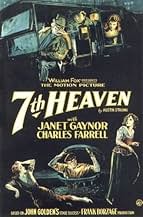IMDb-BEWERTUNG
7,5/10
4393
IHRE BEWERTUNG
Füge eine Handlung in deiner Sprache hinzuA street cleaner saves a young woman's life, and the pair slowly fall in love until war intervenes.A street cleaner saves a young woman's life, and the pair slowly fall in love until war intervenes.A street cleaner saves a young woman's life, and the pair slowly fall in love until war intervenes.
- 3 Oscars gewonnen
- 9 Gewinne & 2 Nominierungen insgesamt
Henry Armetta
- Extra
- (Nicht genannt)
Lewis Borzage Sr.
- Streetlamp Lighter
- (Nicht genannt)
Dolly Borzage
- Street Girl
- (Nicht genannt)
Mary Borzage
- Bullet Factory Worker
- (Nicht genannt)
Sue Borzage
- Street Girl
- (Nicht genannt)
Italia Frandi
- Extra
- (Nicht genannt)
Venezia Frandi
- Extra
- (Nicht genannt)
Frankie Genardi
- Little Boy
- (Nicht genannt)
Lois Hardwick
- Extra
- (Nicht genannt)
Ausgewählte Rezension
Much has been made of Murnau, but I'm more impressed by Borzage.
Yes, the subject matter is more lowbrow, but it is also more fully integrated into the cinematic flow, perhaps as a result.
I'm told this is his best in terms of what impresses me: the integration of space.
Nearly every shot is framed, not in two dimensions by three. There's impressive use of vertical space as well, even incorporating it into the story. Though the story is simple (love, war, return) it has certain narrative elements that bind it to space, and these aren't afterthoughts but essential elements of the story that rest easily in the big holes left by melodrama.
The love nest is literally on the seventh floor. Our hero literally starts in the sewer. He is elevated by intercession of the church, which provides him with a pair of religious medals. If the sewer-heaven dimension is vertical, these medals provide for horizontal space overlay via a sort of spiritually pure love each day at 11.
But the space idea is carried in every frame as well. Its not layers like Kurosawa with give us. Nor a camera that would explore and define space like Hitchcock the camera is stationary here. But its deep.
Gaynor is impressive.
Oh, and it has that most spatial of drugs: absinthe.
Ted's Evaluation -- 3 of 3: Worth watching.
Yes, the subject matter is more lowbrow, but it is also more fully integrated into the cinematic flow, perhaps as a result.
I'm told this is his best in terms of what impresses me: the integration of space.
Nearly every shot is framed, not in two dimensions by three. There's impressive use of vertical space as well, even incorporating it into the story. Though the story is simple (love, war, return) it has certain narrative elements that bind it to space, and these aren't afterthoughts but essential elements of the story that rest easily in the big holes left by melodrama.
The love nest is literally on the seventh floor. Our hero literally starts in the sewer. He is elevated by intercession of the church, which provides him with a pair of religious medals. If the sewer-heaven dimension is vertical, these medals provide for horizontal space overlay via a sort of spiritually pure love each day at 11.
But the space idea is carried in every frame as well. Its not layers like Kurosawa with give us. Nor a camera that would explore and define space like Hitchcock the camera is stationary here. But its deep.
Gaynor is impressive.
Oh, and it has that most spatial of drugs: absinthe.
Ted's Evaluation -- 3 of 3: Worth watching.
Handlung
WUSSTEST DU SCHON:
- WissenswertesFor Chico and Diane's dramatic ascent to the apartment loft - the titular "7th Heaven" - a three-story elevator scaffold was constructed that would be able to follow the pair from the ground level to the apartment door on the top floor. The camera dollies forward onto an elevator platform and then is raised (via a system of ropes and pulleys) through the vertical set, viewing Janet Gaynor and Charles Farrell as they climb the long spiral staircase, as though the viewer is passing through each floor on the ascent. Action is staged with background actors on various floors to give the impression that the set is a lived-in building, and a lighting gag (where Farrell lights a match in a darkened alcove) is used to mask a cut in order to give the audience the experience of a continuous, flowing camera movement up to the sky.
- VerbindungenFeatured in Precious Images (1986)
Top-Auswahl
Melde dich zum Bewerten an und greife auf die Watchlist für personalisierte Empfehlungen zu.
- How long is 7th Heaven?Powered by Alexa
Details
- Erscheinungsdatum
- Herkunftsland
- Sprachen
- Auch bekannt als
- Das Glück in der Mansarde
- Drehorte
- Produktionsfirmen
- Weitere beteiligte Unternehmen bei IMDbPro anzeigen
Box Office
- Budget
- 1.300.000 $ (geschätzt)
- Laufzeit1 Stunde 50 Minuten
- Sound-Mix
Zu dieser Seite beitragen
Bearbeitung vorschlagen oder fehlenden Inhalt hinzufügen

Oberste Lücke
By what name was Im siebenten Himmel (1927) officially released in India in English?
Antwort

















